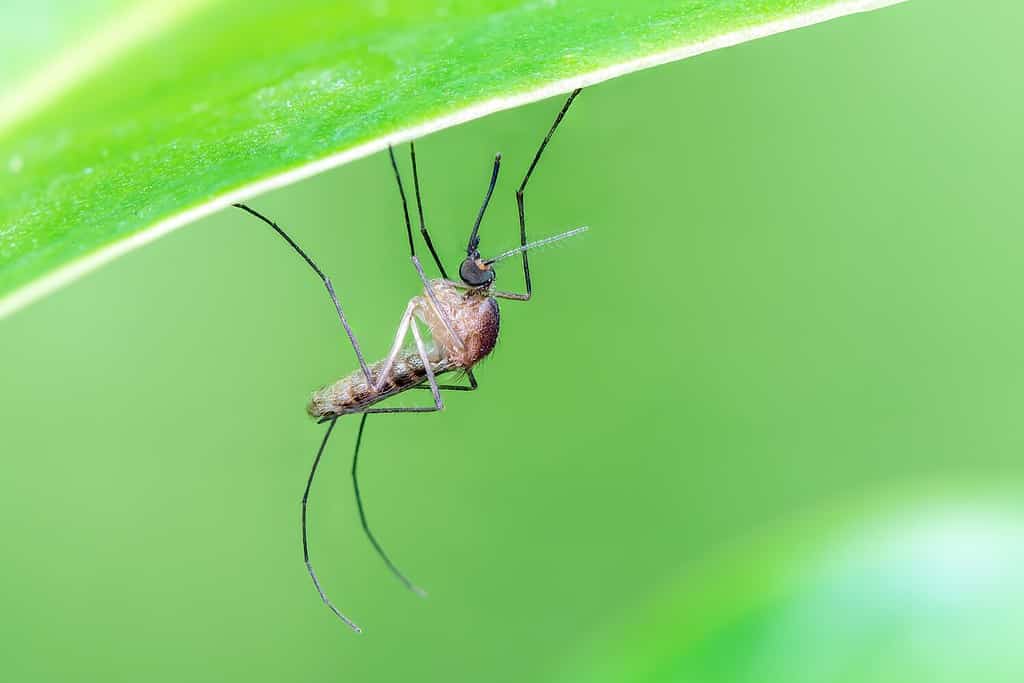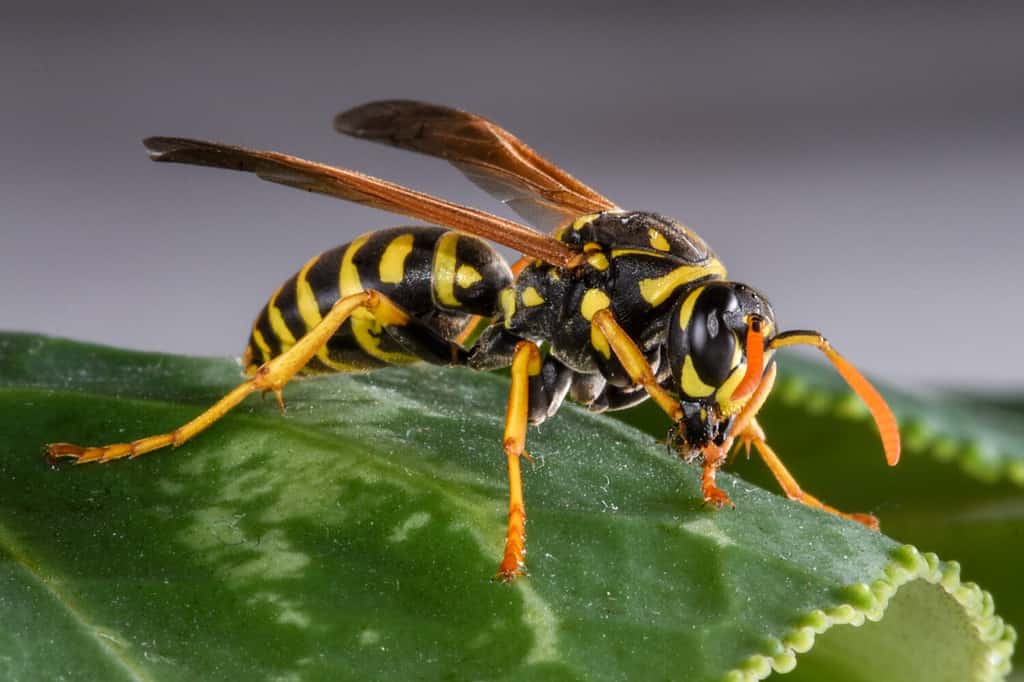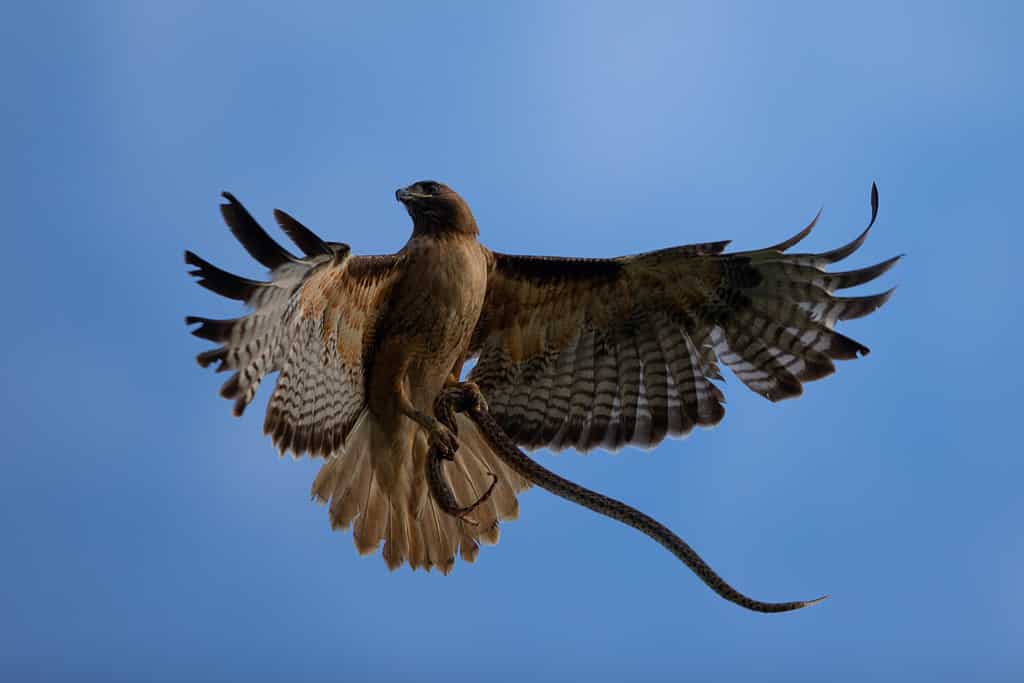Want to learn more about Wyoming’s most dangerous animals? Check out the state’s eight most dangerous land animals.
The 3 Most Dangerous Animals in Wyoming’s Skies
1. Mosquitos

Mosquitos are the deadliest flying insect in Wyoming.
©Narupon Nimpaiboon/Shutterstock.com
These flying insects live throughout Wyoming, bugging people as they try to enjoy their day.
While not all mosquito species bite, the ones that do bite leave swollen, itching spots on the skin.
Regardless of species, female mosquitos are the only ones that bite. They need blood to give them strength to lay eggs.
Both male and female mosquitos have a “proboscis,” a mouth part. Females use their long, sharp proboscis to pierce the skin and suck out blood. The males’ proboscis’ are not strong enough to break skin.
Why Mosquitos are Deadly
The deadliest mosquitos bite and spread germs as they do so. These mosquitos are “vectors,” or insects that can spread germs to humans and animals. They usually carry germs and parasites, which they get from the people and animals they bite.
Mosquitos in Wyoming in 2023
Wyoming is experiencing a worse year of mosquitos than they have in over a decade.
Mosquitos spread the West Nile Virus, which comes with terrible symptoms. Those lucky enough to experience only mild symptoms may suffer from a fever, headache, and diarrhea, among others. Severe West Nile Virus becomes neuroinvasive. It can cause symptoms like disorientation, tremors, and even paralysis.
By September 2023, 20 people in Wyoming had been diagnosed with West Nile Virus (WVN). They say it’s likely that many others have contracted the virus but did not become sick enough to seek testing.
12 of the 20 cases have been severe, and one older woman died from the virus.
2. Yellowjackets

People with allergies can die from yellowjacket stings. A swarm of yellowjackets can also be deadly.
©Randy Runtsch/Shutterstock.com
Yellow jackets are a type of wasp with bold, contrasting yellow and black stripes. They use these colors to warn potential predators about the dangers of their sting.
There are 11 species of yellow jackets in Wyoming. The two most common species are the Aerial and Western Yellowjackets.
Western Yellowjackets live in burrows under the ground or holes in man-made structures. Those who aren’t careful may step on these nests and face the wrath of these stinging insects.
Unfortunately for humans and animals, female yellow jackets can sting repeatedly without dying. They aren’t afraid to repeatedly sting if they feel they or their nest is threatened.
Aerial Yellowjackets make their homes high up in trees or underneath overhangs.
Baldface “Hornets” are Yellowjackets
Baldface “hornets” are a widespread flying menace in Wyoming. They get their name from the contrasting creamy white and black markings on their faces.
These insects are called “hornets.” Yet, they are a type of aerial Yellowjacket.
How People Die From Yellowjacket Stings
The most common reason people die from Yellowjacket stings is if they’re allergic. If they can’t get medical attention, it only takes 15-30 minutes to die from a severe allergic reaction.
People can die from the toxins in the wasp’s stingers, though it’s far less common.
It takes the toxin from about 1,500 stings to kill an adult man. That number is far less — about 300-400 stings — for children. So, someone would have to be attacked by a swarm for this to happen.
3. Birds of Prey

Birds of prey are some of the most dangerous animals in Wyoming if you’re a small bird, mammal, or reptile.
©ranchorunner/Shutterstock.com
These amazing birds aren’t deadly to humans. Yet, they are spectacular hunters who go after various small animals.
Birds of prey are birds that grab their prey with their feet. There are some exceptions — like vultures and condors — who don’t use their feet to hunt. We still refer to them as “birds of prey.”
These magnificent creatures are often referred to as “raptors.” The term raptor means “seized” or “plunderer.” The number makes sense when considering their hunting habits.
For example, some birds of prey are accipiters — or ambush hunters. Wyoming’s accipiters are Cooper’s hawks, northern goshawks, and sharp-shinned hawks.
They sit on a perch at the forest’s edge, looking for small birds and mammals. When they spot their prey, they launch themselves at full speed to chase and capture the animal.
Here are many of the birds of prey that live in Wyoming:
- American kestrel
- Bald eagle
- Broad-winged hawk
- Cooper’s hawk
- Merlin
- Northern goshawks
- Northern harrier
- Osprey
- Peregrine falcon
- Red-shouldered hawk
- Red-tailed hawk
- Sharp-shinned hawk
- Turkey vulture
The photo featured at the top of this post is © Sulae/Shutterstock.com
Thank you for reading! Have some feedback for us? Contact the AZ Animals editorial team.






